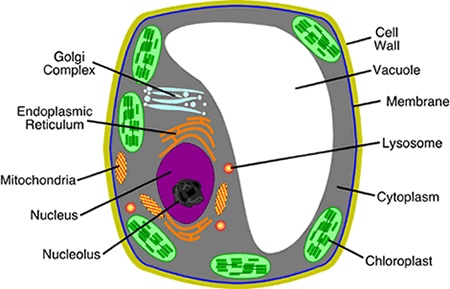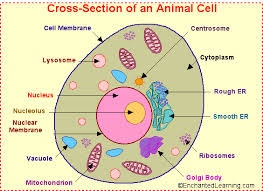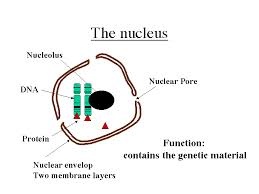Nucleus:
Nucleus is present in all Euyokaryotic cells but it is not present in Prokaryotic cells. Nucleus was discovered by Robert Brown in 1831.
Nucleus is the most important part of the cell. It is also called “brain” of cell because it controls all function and activities of the cell.
In plant cell Nucleus is present at the center of the cell

while in animal cell it is present at one side of cell.

Parts of Nucleus:
Nucleus consist of the following parts.:

1. Nuclear membrane:
Nucleus of the cell is bounded by a membrane called Nuclear membrane. It has small pores that act as a semi permeable membrane.
2. Nucleoplasm:
It is granular substance inside the nuclear membrane. It contains one or two nucleoli and chromosomes.
3.Nucleolus:
Nucleolus is a dark spot present in the Nucleoplasm. RNA is formed inside the Nucleolus.
4. Chromosomes:
Chromosomes are present in the Nucleus. Chromosomes are in the form of fine threads. They are composed of DNA and histone proteins. DNA is responsible for transfer of hereditary characters from parents to their young ones. Chromosomes have a fixed number in particular specie. They occur in pairs in a diploid cell. For example human has 23 pairs of chromosomes or 46 chromosomes.
5. Cytoplasm with organelles:
The organic and inorganic substances in between nuclear membrane and cell membrane are called cytoplasm. It is a semi viscous and semi transport substance.
It has two parts:
1. soluble
2. Insoluble
Cytoplasm consists of 90% of water and 10% of other organic and in organic substances. It contains many chemicals. Cytoplasm contains small structures known as “Organelles”. The important organelles in Cytoplasm are Mitochondria, Golgi bodies, Ribosomes, Endoplasmic reticulum, Lysosomes, Plastids, Centrioles and Vacuoles.

Continued in PART 3 my coming blog

.In PART 3 I"ll describe all the organelles named above .



